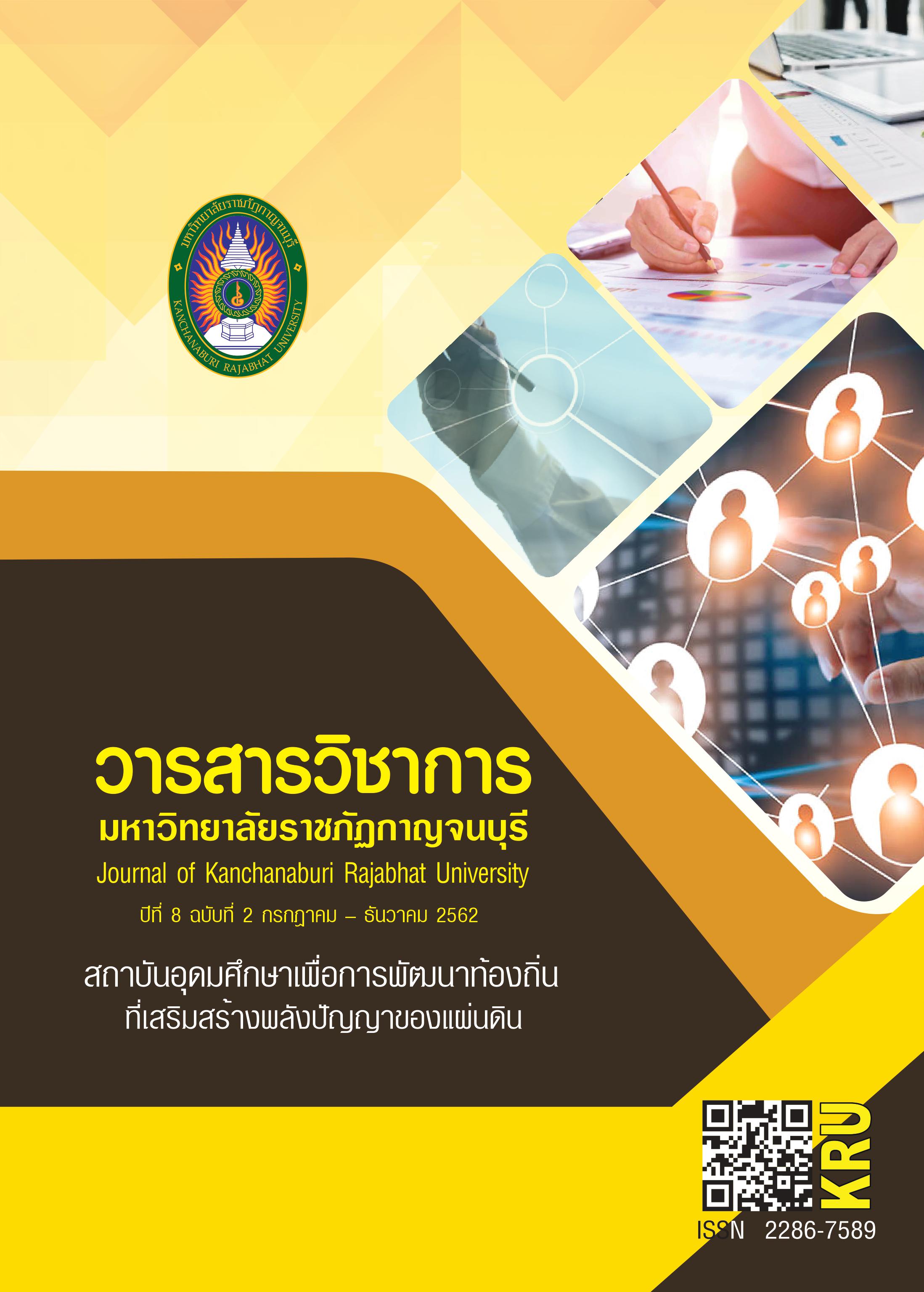DEVELOPMENT OF SPICY PALMYRA PALM CANDY
Main Article Content
Abstract
This study aims at developing the product of spicy palmyra palm candy made from ripe palm fruits grown in Huai Saphan village, Nongrong subdistrict, Kanchanaburi province. The product was developed by mixing ripe palm pulp with pineapple pulp at four different ratios (%) of total weight including 80:20, 70:30, 60:40, and 50:50. The product quality was evaluated using sensory evaluation test, water activity (aw), color measurement, shelf-life evaluation, and content of phenolic and beta-carotene substances. The results showed that the sensory evaluation using 9-point Hedonic Scale with all ratios possessed low and moderate levels of satisfaction with no statistical difference at (p>0.05), the ratio possessing a high level of satisfaction in all aspects was 80:20 which was a recipe that contained the highest amount of ripe palm pulp. The lowest value of water activity (aw= 0.55) resulted in the prevention of food deterioration and microbial growth. The color measurement pointed out that when the greater amount of pineapple pulp was added in the recipe the more of the color values of redness (*a) and yellowness (*b), but the lesser in the lightness value (*L). The texture analysis showed a negative correlation of pineapple pulp and values of hardness, elasticity, cohesiveness, and gumminess—larger amount of pineapple pulp resulted in decreasing values showing that the ratio 80:20 possessed higher values than the ratios 70:30, 60:40, and 50:50; the shelf-life evaluation revealed that no growth of microorganism, yeast, and fungus was found in the control ratio 80:20 during a 30-day-period; and the content determination of phenolic and beta-carotene substances reported that the product contained 0.038±0.00 mgGAE/g of phenolic content, and 0.775±0.26 mg/100g of beta-carotene content the small amounts indicated that the product lacked of antioxidant efficiency.
Article Details
References
จาก https://www.pharmacy.mahidol.ac.th/th/knowledge/article/429.
จินตนา วิบูลย์ศิริกุล และ พรชนก ชัยชนะ. (2560). คุณภาพเนื้อตาลสุกที่ผ่านการให้ความร้อน. เพชรบุรี :
สาขาวิชาวิทยาศาสตร์ และเทคโนโลยีการอาหาร คณะเทคโนโลยีการเกษตร มหาวิทยาลัยราชภัฏเพชรบุรี.
เชาวลิต อุปฐาก วไลภรณ์ สุทธา และปานทิพย์ ผดุงศิลป์. (2556). การศึกษากรรมวิธีการทำเปลือกแตงโมปรุงรส. กรุงเทพฯ :
สาขาวิชาอาหารและโภชนาการ คณะเทคโนโลยีคหกรรมศาสตร์ มหาวิทยาลัยเทคโนโลยีราชมงคลพระนคร.
ธเนศ ว่องอาทรกุล. (2557). การสกัดสารเบต้าแคโรทีนจากกระแตไต่ไม้ ผักกูด และผักแว่น. วิทยานิพนธ์หลักสูตรปริญญา
วิศวกรรมศาสตรมหาบัณฑิต สาขาวิชาวิศวกรรมเคมี คณะวิศวกรรมศาสตร์มหาวิทยาลัยเทคโนโลยีพระจอมเกล้าธนบุรี.
ปรรัตน์ ศุภมิตรโยธิน. (2556). เทคโนโลยีผักและผลไม้. กรุงเทพฯ: โอเดียนสโตร์.
พรพล รมย์นุกูล. (2545). การถนอมอาหาร. กรุงเทพฯ: โอ.เอส.พริ้นติ้ง เฮ้าส์.
รุ่งนภา พงศ์สวัสดิ์มานิต และดร.ไพศาล วุฒิจำนงค์. (2545). การประเมินอายุการเก็บรักษาผลิตภัณฑ์อาหาร.
เอกสารประกอบการสัมมนา-อบรมวิชาการด้านอุตสาหกรรมอาหาร. วารสารจาร์พา, 9 (68), 48-63.
สำนักงานมาตรฐานผลิตภัณฑ์ชุมชน. (2547). มาตรฐานผลิตภัณฑ์ชุมชน ผลไม้หยี 521/2547. กรุงเทพฯ :
กระทรวงอุตสาหกรรม.
เสาวลักษณ์ จิตรบรรเจิดกุลและนพรัตน์ วงศ์หิรัญเดชา. (ม.ป.ป.). การปรับปรุงคุณภาพและมาตรฐานของผลไม้กวน. สงขลา :
สาขาวิชาวิทยาศาสตร์และเทคโนโลยีอาหาร คณะเทคโนโลยีการเกษตร มหาวิทยาลัยราชภัฏสงขลานครินทร์.
Albuquerque T. L, Silva J. I. J. and Macedo G. R., Rocha M. V. P. (2014). Biotechnological production of xylitol from
lignocellulosic wastes: A review Process Biochemistry. Journal Article In AGRIS Since, 49, 1779–1789.
Akowuah, G.A., Ismail, Z., Norhayati, I. and Sadikun, A. (2005). The effects of different extraction solvents of varying
polarities of polyphenols of Orthosiphon stamineus and evaluation of the free radical-
scavenging activity. Food Chemistry, 93, 311-317.
Alwis D.D.D.H, Chandrika U.G., Jayaweera P.M. (2015). Spectroscopic studies of neutral and chemically oxidized
species of -carotene, lycopene and norbixinin CH2Cl2: Fluorescence from intermediate compounds.
Journal of Luminescence, 158, 60–64.
AOAC. (2005). Official methods of analysis of AOAC international. (18th ed). Washington, D.C.:
The Association of Official Analytical Chemists. AOAC international.
Kamiloglu S., Pasli A. A. , Ozcelik B. , Camp J. V. and Capanoglu E. (2015). Influence of different
processing and storage conditions on in vitro bioaccessibility of polyphenols in black
carrot jams and marmalades. Food Chemistry, 186, 74–82.
Nagata, M. and Yamashita, I. (1992). Simple method for simultaneous determination of chlorophyll and
carotenoids in tomato fruit, Journal of the Japanese Society for Food Science and Technology,
39, 925-926.


